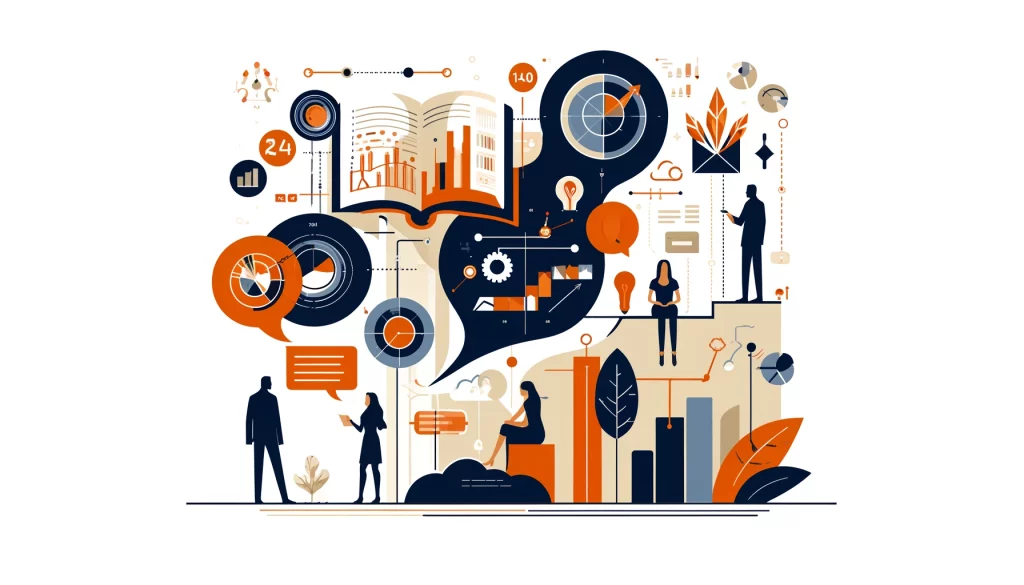
Data Storytelling

In the age of massive data, businesses face an inundation of vast amounts of information from various sources. However, having access to raw data alone is not sufficient to drive meaningful change and make informed decisions. To truly harness the power of data, organizations must master the art of data storytelling. By combining data science analytics with storytelling, businesses can effectively communicate insights. This approach inspires action and gives them a competitive edge in today’s data-driven landscape.
Understanding Data Storytelling
At its core, data storytelling conveys key insights and findings from a dataset through compelling narratives and visuals. It goes beyond simply presenting numbers and charts on a screen.
Data storytelling aims to frame insights, making them relatable, clear, and actionable for the intended audience. Weaving data into a cohesive story captures attention and evokes emotions. This can inspire individuals to act upon the insights presented.
For example, let’s say a retail company wants to understand customer purchasing patterns. Rather than simply presenting a spreadsheet with sales figures, a data storyteller would craft a narrative around the data.
They might highlight product popularity during specific seasons or how customer demographics influence buying behavior. Additionally, they could demonstrate how promotional campaigns impact sales. By turning raw data into a compelling story, the insights become more accessible and actionable for decision-makers.
The Three Pillars of Data Storytelling
To create effective data stories, three essential components must come together seamlessly: data, narrative, and visualizations.
Data
The foundation of any data story lies in accurately and comprehensively analyzing the data. This entails conducting in-depth exploratory data examination, applying statistical techniques, and utilizing machine learning algorithms to unveil significant patterns and insights. To support the narrative, ensure that the data is reliable, relevant, and carefully curated.
Narrative
A narrative is the thread that ties the data together, giving it context and meaning. The storyline guides the audience through the insights, highlighting key findings and their implications. The narrative should be clear, concise, and customized to the target audience, considering their background knowledge and interests. It should also have a logical flow, leading the audience towards a clear conclusion or call to action.
Visualizations
Visuals are the medium through which data stories come to life. They can take various forms, such as charts, graphs, infographics, interactive dashboards, or even videos. Effective visualizations simplify complex data, making it easier to understand and digest. Design them with the audience in mind, using suitable colors, fonts, and layouts to improve understanding and engagement.
For instance, consider a healthcare organization that wants to raise awareness about the importance of regular check-ups. A data storyteller could create an infographic. This infographic would merge data on disease prevalence, early detection benefits, and preventive care impacts. By using visually appealing charts, icons, and illustrations, the story becomes more engaging and memorable for the audience.
The Power of Data Storytelling
Data storytelling offers numerous benefits for businesses and organizations. Here are a few key reasons why it is crucial:
- Effective Communication: Data storytelling bridges the gap between complex data and easy-to-understand insights. By presenting data in a narrative format, it becomes more accessible and relatable to a wider audience. Decision-makers, stakeholders, and even non-technical individuals can understand the significance of the insights. They can also grasp the implications for the business.
- Compelling and Memorable: In today’s fast-paced digital world, capturing and retaining attention is a challenge. Data storytelling merges facts and figures with engaging storytelling elements, enhancing the message’s impact and making it more memorable. By evoking emotions and creating a connection with the audience, data stories leave a lasting impact and inspire action.
- Data-Driven Decision Making: Data storytelling transforms raw data into actionable insights that drive informed decision-making. By presenting data in a clear and persuasive manner, organizations can make data-driven decisions with confidence. Data stories help stakeholders understand the ‘why’ behind numbers, enabling better decision-making.
A marketing team, for instance, might use data storytelling to illustrate a recent campaign’s outcomes. They could merge data on reach, engagement, conversions, and revenue to craft a persuasive narrative. This narrative highlights the campaign’s achievements and pinpoints areas for enhancement. A data story helps secure budgets, justify future investments, and align teams towards common goals.
Crafting Effective Data Narratives
To create powerful data stories that resonate with your audience, consider the following tips:
- Know Your Audience: Understanding your target audience is crucial for effective data storytelling. Consider their background, expertise, and expectations when crafting your narrative. TCustomize language, visuals, and details to resonate and address their specific needs.
- Start with a Clear Purpose: Before diving into the data, define the purpose and objectives of your data story. Define your objective: inform, persuade, or inspire action. This clarity will guide your data examination, narrative construction, and visual design.
- Simplify Complex Data: Data can be overwhelming and intimidating, especially for non-technical audiences. Use language that is easy to understand, avoid jargon, and break down complex concepts into digestible pieces. Focus on the key insights and steer clear of unnecessary details.
- Use Compelling Visuals: Visuals are a powerful tool for conveying information quickly and effectively. Use charts, graphs, and infographics to showcase patterns, trends, and relationships in the data. Choose visuals that suit the presented data and ensure they are clear, accurate, and visually appealing.
- Incorporate Storytelling Elements: To make your data story engaging and memorable, incorporate storytelling elements such as characters, conflicts, and resolutions. Use analogies, metaphors, and real-life examples to make the data relatable and emotionally resonant. Create a narrative arc that guides the audience through the insights and leads to a clear conclusion or call to action.
- Provide Context and Insights: Data alone is not enough; it needs context to be meaningful. Provide background information, explain the significance of the findings, and draw connections between different data points. Share insights and recommendations based on the data, helping the audience understand the implications and take appropriate actions.
Collaborate and Iterate: Data storytelling is a collaborative process that involves multiple stakeholders, including data analysts, domain experts, and communication specialists. Foster a culture of collaboration and encourage feedback and iteration. Refine your data stories with input to ensure accuracy, impact, and alignment with your message.
The Future of Data Storytelling
As businesses gather more data, the importance of storytelling grows. Here are some trends and opportunities that showcase the future :
- Interactive and Immersive Experiences: Advancements in technology are enabling more interactive and immersive data storytelling experiences. Businesses utilize interactive tools such as dashboards and virtual reality to create engaging, personalized data stories. Audiences can then explore and interact with data in innovative ways.
- Democratization of Data Storytelling: With the rise of self-service analytics and data visualization platforms, data storytelling is now accessible to more users. Non-technical individuals can now create compelling data stories without relying on specialized skills or extensive technical knowledge. This democratization of data storytelling empowers more people within organizations to leverage data for decision-making and communication.
- Real-Time and Predictive Storytelling: As data becomes more real-time and predictive analytics techniques advance, data storytelling will evolve to incorporate dynamic and forward-looking narratives. Real-time data stories can provide up-to-the-minute insights, enabling organizations to respond quickly to changing circumstances. Predictive storytelling, on the other hand, can showcase potential future scenarios based on historical data and machine learning models, helping businesses anticipate trends and make proactive decisions.
- Integration with Business Strategy: Data storytelling will increasingly be integrated into overall business strategy and decision-making processes. Rather than being a standalone activity, data storytelling will become a core competency for organizations, guiding strategic planning, performance management, and stakeholder communication. Data stories will be used to align teams, set goals, and track progress towards desired outcomes.
Conclusion
The ability to effectively communicate insights through data storytelling is a critical skill for businesses and individuals alike. By combining the power of data analysis with the engaging elements of storytelling, organizations can transform raw data into actionable insights that drive meaningful change. Data storytelling enables businesses to make informed decisions, inspire action, and gain a competitive advantage in the marketplace.
To master the art of data storytelling, organizations must invest in developing the necessary skills and tools. This includes fostering a data-literate culture, providing training and resources for data storytelling techniques, and adopting technologies that facilitate data exploration, visualization, and communication. By empowering individuals and teams to become effective data storytellers, businesses can unlock the full potential of their data assets and drive success in the data-driven era.
